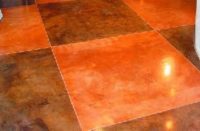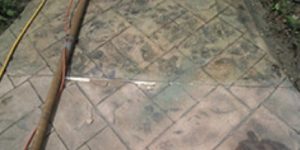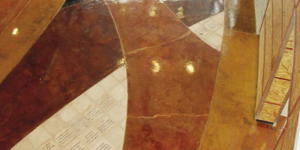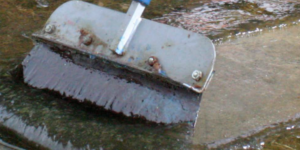
If you install stamped concrete, you should be maintaining and resealing stamped concrete. You already have all the equipment you need, and unless you have a lot of failures with your work, you probably have the experience and training you need as well. Offering an annual maintenance program on your work, or any stamped concrete work for that matter, is a good source of revenue that does not require much in the way of equipment or mental gymnastics. If you install stamped concrete, collect a check, and hope the homeowner loses your business card after you leave, you are missing the boat.
As we all know, stamped concrete is a premium product, and being so, it typically attracts more attention from the owner. For those who have a stamped concrete patio, pool deck or driveway, each spring usually involves some type of an assessment of the overall look of their concrete. They paid a premium for their stamped concrete, so it usually goes without saying they want it to look good.
If their stamped concrete does not meet their expectations, the default conclusion always seems to be, “It must be time to reseal.” In my years of troubleshooting, I have found a lack of understanding, predominately at the homeowner level, of the expected working life of sealers and of how best to maintain their stamped concrete. I have also found a lack of qualified installers marketing and selling maintenance programs for stamped concrete. With a large segment of those owning stamped concrete looking for maintenance professionals, the demand is high, and with few professionals offering these services, the supply is low. You don’t need to be an economist to see that maintaining stamped concrete could be a nice source of revenue for the stamped concrete installer.
Common misconceptions
Some of the common industry misconceptions start when it comes to sealers on stamped concrete and how to best maintain them. For starters, it’s more than just resealing. Maintenance can include cleaning, patching and recoloring as well as resealing.
I have found that as a whole, installers, designers, and homeowners have become better educated in recent years in regard to sealer performance. The Internet, along with a better-educated professional installer, has a lot to do with that.
Still, when it comes to maintenance and resealing of stamped concrete, life span and final appearance need to be discussed with any prospective client. No matter the brand or chemistry, sealers used on stamped concrete all have a life span. They are not bulletproof and in fact are often nothing more than thin layers of plastic.
Reseal lifespan
Just like the initial sealer has a life span, so does the reseal, and no matter what you do, the stamped concrete will not look like it did when it was first sealed. Just like with your truck, home and body, wear and tear and time have their effect.
There is no hard and fast time to reseal. Don’t make the assumption that all stamped concrete needs to be resealed automatically after 2.5 years. Resealing too often only adds more sealer where it is not needed and can itself create a delaminating failure. Sealer life span will vary based on sealer type, environmental conditions and traffic. I have seen some sealers last six months, while others last five-plus years. The average is about two and a half years for your typical acrylic sealer used on most residential exterior stamped concrete.
I try to find out what sealer was originally used to get an idea of the expected life span. However, I rely on a visual inspection to make the final determination if a reseal is needed. You can also do a crosshatch adhesion test (ASTM D3359) to determine if the sealer is still well-adhered or is coming to the end of its working life. Most sealers will start to look slightly gray or off-white as they come to the end of their working life, with the concrete color matte or natural in appearance.
Cleaning tips
When it comes to the actual process of maintaining stamped concrete, there are a few steps to follow. The first involves good old-fashioned cleaning. Before you start, put away the power washer. There is no need to blast the surface with 2,000-psi water jets. A standard residential garden hose with household soap and a medium-bristle brush will work just fine. A walk-behind scrubber with a medium pad also works on light- to medium-textured surfaces. Follow the soap-and-water scrub with a clean-water rinse and let the patio dry — completely. If there are stains such as oil, leaf litter, sap, pet waste, or white cloudy moisture trap, to name a few of the common ones, additional cleaning or even stripping the sealer may be needed. I have found that solvents like xylene work well. Rust removers, chemical strippers, cleaners with oxidation properties, and organic spot treatments also work well.
If you do plan on treating a spot, test before you do the whole surface. This will ensure the cleaner works but does not create a bigger problem in the process. Once the scrubbing is complete, remove any old worn-out sealer and then clean and dry the slab. At this time, you can then make a determination if the surface really needs to be resealed.
Resealing
If resealing is necessary, I recommend resealing with the original sealer. I know this is not always feasible. However, you can at least make an attempt to find out what sealer was originally applied. At a minimum, always try to stay within the same resin family. Also use compatible materials — water-based on water-based and solvent on solvent. If you don’t know what the original sealer is, always do a test. If the sealers are incompatible, you will know pretty quickly something is wrong. It’s much better to have incompatibility occur on a 10-inch area than on 1,000 square feet.
I am also a big fan of lower solids on reseals. If you don’t know the original sealer, I recommend 20 percent or less solids when resealing. The lower solids allow for easier application, better breathability and better adhesion.
Always strive for coating at a minimum of 400 square feet per gallon when resealing.
Speaking of adhesion, solvent-based sealers exhibit much better adhesion when resealing. This is yet another reason I like solvent-based technology when sealing exterior stamped concrete. If you are using water-based acrylic sealers, a light sanding or scrubbing with a black pad goes a long way in helping the adhesion of the reseal.
If you currently offer a maintenance program for your stamped concrete work, you already know the benefits. But if you haven’t, get started now, what are you waiting for?

















